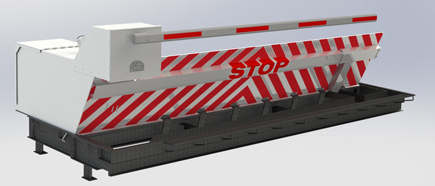Things about Wedge Barriers
Little Known Facts About Wedge Barriers.

14 and the surface 12 to which the obstacle 10 is safeguarded may be made from concrete - Wedge Barriers. 2, the barrier 10 is installed to or consists of an anchor or subframe (e. g., support 30 revealed in FIG. 2 )safeguarded beneath the surface 12. The bather 10 might be bolted to the anchor or safeguarded to the support by other mechanical fasteners. In the detailed personification, the obstacle 10 consists of a wedge plate 16, that includes a portion that is considerably parallel with the surface 12 when the obstacle 10 remains in the withdrawed setting. To put it simply, cars or individuals might pass over the barrier 10 when the barrier 10 remains in the retracted placement and experience minor altitude about the surface area 12 while on the barrier 10. As talked about carefully listed below, when the barrier 10 remains in the deployed placement, the wedge plate 16 is held and supported in a raised setting by a lifting mechanism of the barrier 10. Furthermore, the elements 18 might be bolted or otherwise mechanically paired to each other. In this way, repair service or substitute of several components 18 may be simplified and streamlined. That is, fixing or replacement of solitary parts
18 may be done extra quickly, conveniently, and price successfully. FIG. In specific embodiments, the anchor 30 might be a steel framework including plates, beam of lights(e. g., I-beams ), and/or other frameworks that are secured within the structure 14, which might be concrete. At the surface 12, an upper side 28 of the anchor 30 might be at the very least partially revealed
, thereby making it possible for the accessory of the obstacle 10 to the support 30. g., threaded holes)in one or even more beams or plates of the anchor 30 might be exposed to the surface 12. In this fashion, screws more helpful hints 32 or other mechanical fasteners might be used to secure the obstacle 10 to the support 30. As the obstacle 10 is mounted to the surface 12 of the structure 14, collection of particles and various other material beneath the barrier may be lowered, and components of the bather 10 might not be exposed to listed below quality environments. As suggested by referral numeral 52, the lifting mechanism 50 consists of parts got rid of under the wedge plate 16. The components 52 underneath the wedge plate 16 may include an electromechanical actuator, a web cam, one or more web cam surface areas, and so forth. In addition, the training mechanism 50 consists of a springtime why not find out more setting up 54
The spring rod 58 is paired to a webcam(e. g., camera 80 revealed in FIG. 4) of the lifting system 50. The springtimes 60 disposed regarding the springtime rod 58 are kept in compression by spring supports 62, including a dealt with spring support 64. That is, the set spring support 64 is taken care of about the foundation 14 et cetera of the bather 10.
About Wedge Barriers
g., springtime support 65 )might be taken care of to the end of the spring rod 58 to enable compression of the springtimes 60. As the springs 60 are compressed in between the spring supports 62, the spring setting up 54 get more creates a force acting upon the cam combined to the spring rod 58 in an instructions 66. The continuing to be force applied to
the cam to deploy release wedge plate 16 may be provided offered an electromechanical actuator 84 or other actuator. The spring setting up 54 and the actuator 84(e. g., electromechanical actuator)may run together to equate the web cam and lift the wedge plate 16.
As discussed over, in the released position, the wedge plate 16 serves to block gain access to or travel past the obstacle 10. The obstacle 10(e. g., the wedge plate 16 )may block pedestrians or lorries from accessing a residential property or path. If an automobile is traveling in the direction of the released wedge plate 16(e. For example, in one circumstance, the safety legs 86 might be extended throughoutmaintenance of the barrier 10.